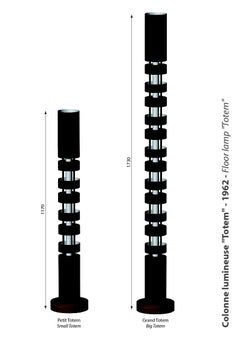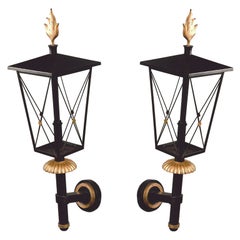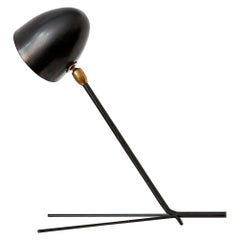French Modern
to
4
1
3
2
2
1
1
1
2
1
1
Color: Black
Serge Mouille - Large Snail Ceiling Lamp
By Serge Mouille
Located in Stratford, CT
A snail shell provides the inspiration for this lamp with its swirling cut out in the circular shade. Light projects downward through the opening while the shade causes light to refl...
Category
21st Century and Contemporary French Mid-Century Modern French Modern
Materials
Aluminum, Steel
Serge Mouille - Agrafee Desk Lamp with Double Swivel
By Serge Mouille
Located in Stratford, CT
36 inches at its highest, this adjustable lamp may affix to many surfaces providing direct lighting where it is needed.
Available in white or black. Brass swivels connect the shade...
Category
21st Century and Contemporary French Mid-Century Modern French Modern
Materials
Aluminum, Steel
Serge Mouille, "TOTEM" floor Lamp. Small model 117 cm
By Serge Mouille
Located in London, GB
The TOTEM by Serge Mouille exist in two sizes. The big TOTEM 170 cm and the small TOTEM 117 cm. The fluorescent tube become apparent once switch on. Originally three colors. White, r...
Category
1960s French Minimalist Vintage French Modern
Materials
Walnut
Important Pair of 1950s Wrought Iron Sconces by Gilbert Poillerat
By Gilbert Poillerat
Located in New York, NY
Gilbert Poillerat (1902-1988).
A pair of important and massive partial gilt wrought iron lantern sconces with flame motif
France, 1950s.
Can be used indoor or outdoors.
Dimensions: 4...
Category
1950s French Mid-Century Modern Vintage French Modern
Materials
Wrought Iron
French Art Deco Leleu Mahogany Kneehole Desk
By Jules Leleu
Located in New York, NY
French Art Deco large mahogany kneehole desk with bronze column design trim and leather top. (JULES LELEU)
Category
Early 20th Century French Art Deco French Modern
Materials
Bronze
Related Items
Dakota Jackson French Art Deco Postmodern Mahogany Executive Partners Desk 96"
By Dakota Jackson
Located in Dayton, OH
Vintage Dakota Jackson post modern Art Deco style executive partners desk featuring mahogany with leather insert and stainless steel frame. A V-Shape pattern veneer top with Black Leather inset. 2 pedestal cabinets below: each with 2 standard drawers and 1 file drawer, front and back. Polished Stainless Steel drawer pulls, post, floor plates, and arced trestle supporting desktop. DJ Chelsea Black Leather, Polished Polyresin finish.
Dakota Jackson (born August 24, 1949) is an American furniture designer known for his eponymous furniture brand, Dakota Jackson, Inc.,[1] his early avant-garde works involving moving parts or hidden compartments,[2][3] and his collaborations with the Steinway & Sons piano company.[1]
Jackson helped establish the art furniture movement in 1970s SoHo,[4][5] later becoming a celebrity designer in the 1980s.[6][7][8] His background in the world of stage magic helped him get his first commissions and is often cited as the source of his point-of-view.[6][9]
Early life
Dakota Jackson was born on August 24, 1949, and grew up in the Rego Park neighborhood of Queens, New York.
Stage Magic
Jackson's father, Jack Malon, was a professional magician.[10] Mr. Malon learned the trade from his own father, who studied stage magic in early 20th century Poland.[1]
Jackson began studying magic at a young age and sometimes performed with his father.[11] Jackson's name, in fact, grew out of a road trip to Fargo, North Dakota.[11]
Throughout his adolescence and into his early 20s, Jackson immersed himself in the world of magic.[2] In 1963, Jackson began to perform in talent shows at his junior high school, William Cowper JHS 73 (which is known today as The Frank Sansivieri Intermediate School),[12] and at children's birthday parties.[13] Jackson also began to build his own props, including large boxes for sawing a woman in half and small boxes from which doves would emerge in full flight.[11] Jackson acknowledges the importance of these early experiences with magic to his later career as a furniture designer: "The demands of performance taught me how to discipline myself to achieve aesthetic ends."[1][2][14]
After Jackson graduated from Forest Hills High School in 1967, he continued performing as a magician, working in art galleries, night clubs, touring in the Catskills, and giving private performances at society events.[2][13][15] When he was 17, Jackson had studied with magician Jack London to learn the dangerous bullet catch trick.[16]
"What appealed to me was the notion of doing things that appeared miraculous" Jackson once recalled.[6] "I was interested in spiritualism. I was interested in things like bullet catching, things that really challenged individual sensibilities, that were frightening, on the edge."[2]
He didn't find the opportunity to perform the trick publicly until a decade later at Jackson's final professional performance as a magician.[1] It was documented in Andy Warhol's Interview (magazine), in a story titled "Dakota Jackson bites the bullet."[1][16]
Jackson admits that he sometimes tires of references to his magician background, although he acknowledges it as an important part of his history.[2]
The Downtown Arts Scene
In the late 1960s, Jackson moved into a loft on 28th Street in Chelsea.[1][17] Jackson became part of the Downtown scene, a community of "artists, dancers, performers, and musicians" who moved to the neighborhood for the cheap rent and social life.[1][8][17][18]
In October 1970, Jackson performed with the Japanese group Tokyo Kid Brothers at New York's La MaMa Experimental Theatre Club (also known as Café La MaMa) in a rock musical production called "Coney Island Play" ("Konī airando purē).[19] The show explored themes of cross-cultural communication and understanding[19] and was a follow up to the group's debut performance of "The Golden Bat" at La MaMa earlier that summer.[20][21][22] Jackson played the part of a "clever conjurer."[19]
Over the next few years, Jackson became interested in minimalist dance and performed in the dance companies of Laura Dean and Trisha Brown.[2][15][23]
Jackson credits his exposure to minimalism and minimalist dance in particular as having had a strong influence on his approach to design; in 1989, Jackson told the Los Angeles Times:
For me the essential fineness of a design is in the idea, not the object itself ... In minimalism, the object is pared down to its basic meaning by stripping away all the excrescence ... —those elements that do not contribute to the pure idea.[24]
Design career
In the early 1970s, as he experimented with performance and dance, Jackson began branching out as a special effects consultant to other magicians, film producers, and musicians[2][23] such as Donna Summer.[6][9]
The loft also gave Jackson an opportunity to apply his creativity and building skills: "These were times when lofts were not ... luxury condominiums. These were tough, tough raw spaces ... and we artists, bohemians, creative people, we created our environment. So I had to build".[17][25]
Recognizing his skills as a builder, Jackson decided to shift away from performance and become a full-time maker.[1][15][17] He began making a variety of objects, including furnishings for other artists and magic boxes with hidden compartments for art collectors and galleries.[17][24] Jackson's social connections helped spread word about his work[15] and this led to his first commissions.[1]
Early Commissions
Desk for John Lennon by Dakota Jackson
In 1974, Jackson's career as a designer began when Yoko Ono asked him to build a desk with hidden compartments for husband John Lennon.[26] "She wanted to make a piece of furniture that would be a mystical object; that would be like a Chinese puzzle," Jackson recalled in a 1986 interview published in the Chicago Tribune.[6] The result was a small cubed-shaped writing table with rounded corners reminiscent of Art Deco era style.[15] Touching secret pressure points opened the desk's compartments.[23] This commission helped build Jackson's reputation and allowed him to merge his experience as a magician and performer with his developing interest in furniture.[27]
In 1978, a bed designed for fashion designer Diane von Furstenberg garnered Jackson even more notoriety.[8][10][28] [29] Called "The Eclipse", the bed was described in The New Yorker as "large, astounding, sumptuous, with sunbursts of cherry wood and quilted ivory satin at head and foot."[10] A lighting system positioned behind the headboard switched on automatically at sunset and spread out rays of light "like an aurora borealis,"[2][17] which grew brighter and brighter until turning off at 2 am.[23][30]
Commissions like these continued to come in[8] and Jackson soon became known as a designer to the rich and famous.[30] Some of his other clients from this period included songwriter Peter Allen, Saturday Night Live creator and producer Lorne Michaels, Rolling Stone publisher Jann Wenner, and soap opera actress Christine Jones.[8]
The American Art Furniture Movement and the Industrial Style
In the late 1970s, Jackson was among a small group of artists and artisans producing and exhibiting hand-made furniture in New York.[5][31] Jackson and his peers were part of the "American Art Furniture Movement," a group sometimes called the "Art et Industrie Movement,"[32] named after the leading art furniture gallery of the era,[32] Art et Industrie, founded by Rick Kaufmann in 1976.[33]
In a 1984 Town & Country article titled "Art You Can Sit On," Kaufmann said he created the gallery to "serve as a locus to the public for artists and designers creating new decorative arts."[31] The works on display were "radical objects" that drew from a number of fine art traditions, including "Pop, Surrealism, Pointillism and Dada [which were] "thrown together with the severe lines of the Bauhaus and the Russian avant-garde, mixed with Mondrian's color and filtered through a video sensibility—all to create a new statement."[31] The article described Jackson as a "ten-year veteran of the genre" and pointed to the "clean forms and quiet colors" of his furniture.[4]
Jackson showed a variety of industrial-looking lacquer, metal, and glass works at Art et Industrie, including his Standing Bar (also known as the Modern Bar),[33] a lacquered cabinet that Jackson designed in 1978 for his wife (then-girlfriend) RoseLee Goldberg.[13]
Other works from this period include the T-Bird Desk, Self-Winding Cocktail Table, and the Saturn Stool...
Category
Late 20th Century Art Deco French Modern
Materials
Stainless Steel
H 30 in W 96 in D 42 in
Original Serge Mouille Cocotte Table Lamp
By Serge Mouille
Located in Brooklyn, NY
Original Serge Mouille Cocotte table lamp.
Designed in 1957. Completely original, down to the bullet shaped switch, wiring and electrics.
The Cocotte lamp was originally designed f...
Category
Mid-20th Century French Mid-Century Modern French Modern
Materials
Aluminum, Brass, Steel
Serge Mouille Desk Lamp Saturn
By Serge Mouille
Located in London, GB
Licensed edition from Serge Mouille’s original design
In 1957 Mouille release a variation of the Saturn sconce but as a desk lamp.
Category
21st Century and Contemporary French French Modern
Materials
Brass, Steel
Serge Mouille curved Pendant Ceiling lamp "Bibliothèque" Editions Serge Mouille
By Serge Mouille
Located in London, GB
Indoor use and dry locations only/
US 60 w max E12 120 v 60 HZ
Color available black or white.
Category
1950s Vintage French Modern
Materials
Aluminum
H 38.98 in W 7.49 in D 14.97 in
Serge Mouille pendant ceiling lamp "Bibliothèque" by Les Editions Serge Mouille.
By Serge Mouille
Located in London, GB
Ceiling lamp designed to illuminate bookshelf in libraries or artwork
the pivoting lampshade works well alone or in grouped installations.
Custom drop lengths to order.
Category
1950s Vintage French Modern
Materials
Aluminum
H 39.38 in W 14.97 in D 7.49 in
Agrafée with 2 Swivels by Serge Mouille
Located in Geneve, CH
Agrafée with 2 swivels by Serge Mouille
Dimensions: D 33 x H 68 cm
Materials: Brass, steel, aluminum
One of a King. Numbered.
Also available in different color.
All our lamps can be wired according to each country. If sold to the USA it will be wired for the USA for instance.
Designed to control the direction of light, the Serge Mouille Agrafée 2 ball joint lamp...
Category
2010s French Post-Modern French Modern
Materials
Aluminum, Brass, Steel
Serge Mouille Medium Snail Escargot Pendant Ceiling Lamp
Located in London, GB
The slightly smaller light- sculpture in 60 cm.
Category
1950s Vintage French Modern
Materials
Aluminum
Set of French Gilt Iron Sconces After Gilbert Poillerat
By Maison Charles, Maison Raphael, Maison Jansen, Maison Baguès, Gilbert Poillerat
Located in Houston, TX
Set of French gilt iron sconces after Gilbert Poillerat.
Stunning pair of French gilt iron sconces in the manner of Gilbert Poillerat. These fantastic torch form sconces have a beau...
Category
1940s French Hollywood Regency Vintage French Modern
Materials
Iron
French Art Deco Desk
By Émile-Jacques Ruhlmann
Located in Westwood, NJ
In the Ruhlman Manner, this French Art Deco desk, true to its French lineage, is a study in curves and angles. Two shapely filing drawers flank th...
Category
21st Century and Contemporary Vietnamese Art Deco French Modern
Materials
Mahogany
Serge Mouille 'Snail' Ceiling Lamp
By Serge Mouille, Editions Serge Mouille
Located in Glendale, CA
Serge Mouille 'Snail' ceiling lamp. Originally designed in 1955, this iconic lamp is still made by Editions Serge Mouille in France using many of the origin...
Category
21st Century and Contemporary French Mid-Century Modern French Modern
Materials
Steel, Aluminum, Brass
Serge Mouille "Cocotte" Desk Lamp
By Serge Mouille
Located in London, GB
A Serge Mouille desk lamp model "Cocotte" in black or white.
Category
2010s French French Modern
Materials
Aluminum
18th Century George II Mahogany Kneehole Desk
Located in Dublin 8, IE
18th century George II mahogany knee hole desk, with one long drawer above central cupboard door flanked by six short drawers raised on bracket...
Category
18th Century Irish George II Antique French Modern
Materials
Mahogany



